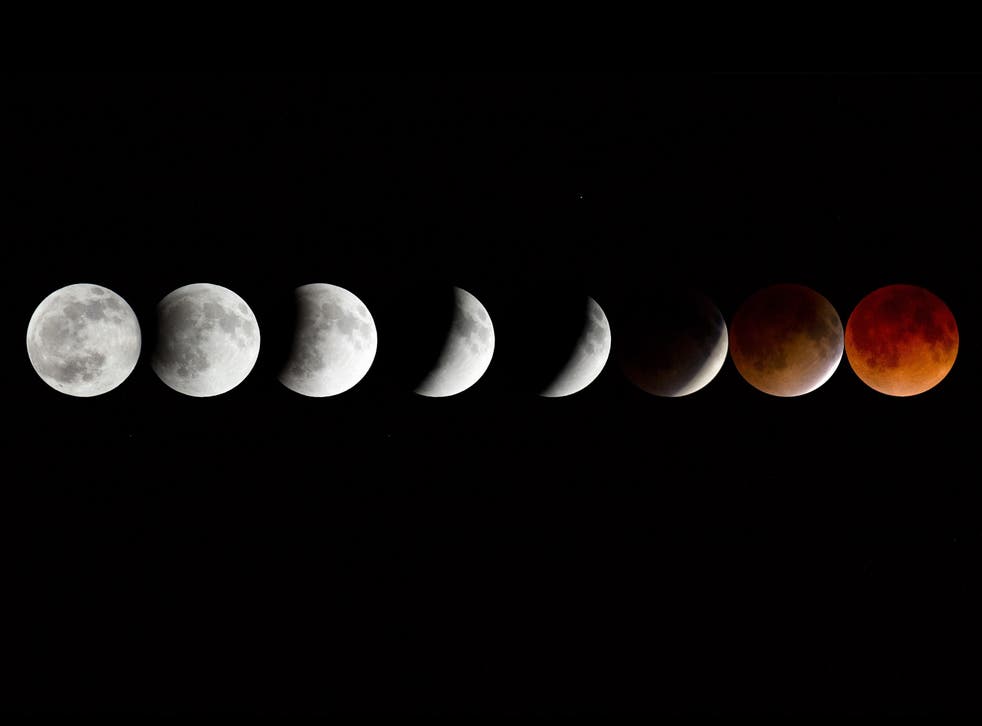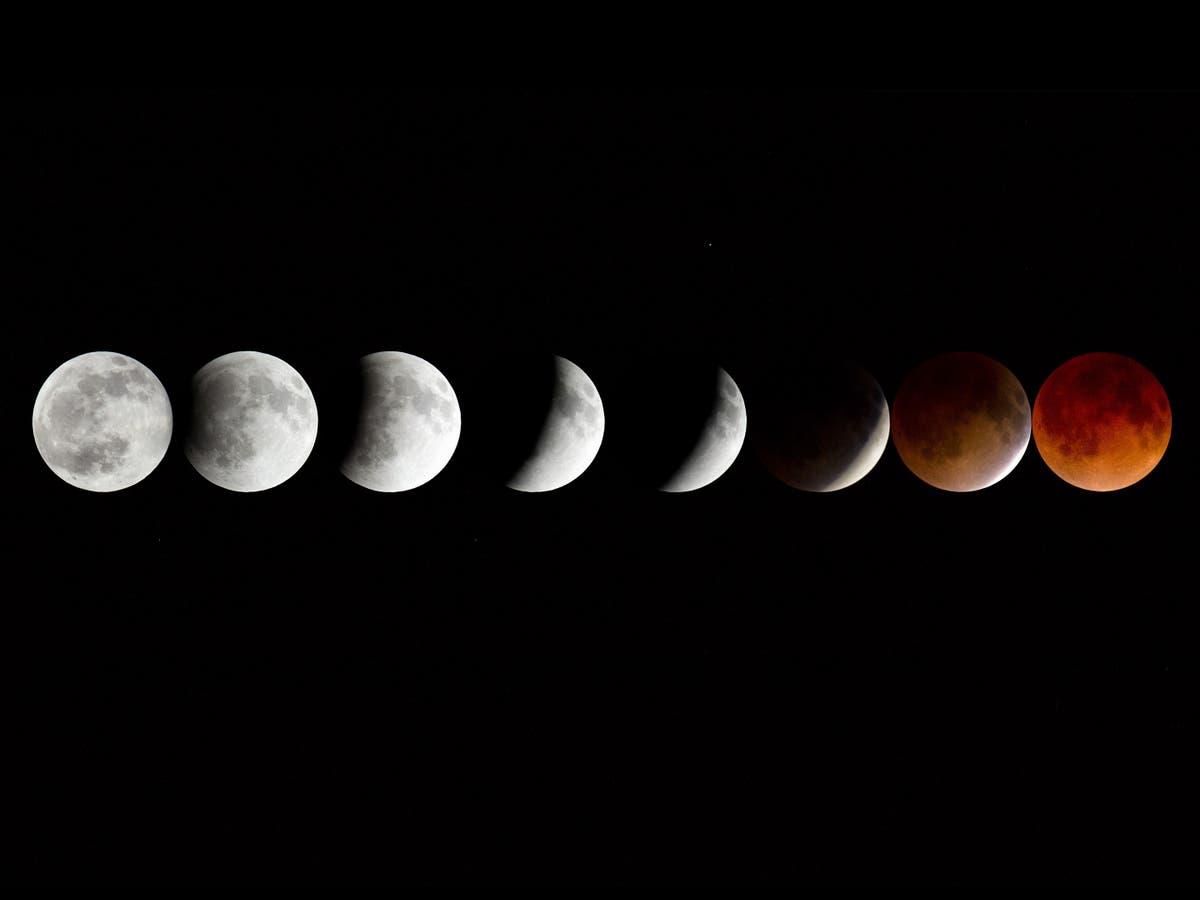Lunar Eclipse 2021 LIVE: Beaver ‘blood’ full moon will be longest eclipse in 580 years

The almost-total lunar eclipse on 19 November will be the longest in more than 500 years
(Getty Images/iStockphoto)
The Moon is about to fall into the Earth’s shadow for the longest duration since the 15th Century, offering stargazers a unique opportunity to observe a lunar eclipse.
The celestial spectacle coincides with the Full Moon, traditionally known as the Beaver Moon by Native American tribes, and will be visible across large parts of the globe, including North America and partially in the UK.
The near-total eclipse will peak for 3 hours and 28 minutes on the night of the 18-19 November, beginning at 9.02am GMT.
The full passing of the Full Moon – which itself peaks at 8.57am GMT – through Earth’s shadow will last more than six hours.
The whole event will be visible across the US but the arrival of the Sun on Friday morning will prevent people in the UK from seeing the latter half of it.
You can follow all the latest Moon action right here.
A blood moon prophecy
According to some Christians, the Bible predicts that a series blood moons has already heralded the end of the world in 2014-15.
John Hagee, a Texas megachurch pastor in Texas, was among several evangelical leaders to assign eschatological significance to a sequence of four lunar eclipses within 18 months, known to astronomers as a tetrad, that all coincided with Jewish holidays.
Mr Hagee linked that event to passages in the Old Testament’s Book of Joel and the New Testament’s Book of Acts, which promise that “the sun shall be turned into darkness, and the moon into blood”.
“I believe that the heavens are God’s billboard; that he has been sending signals to Planet Earth but we just have not been picking them up,” said Mr Hagee in a sermon.
However, tetrads are not particularly rare, with eight scheduled to occur between 2015 and 2100. Nor is it unusual for lunar eclipses to fall on a Jewish festival, since the Jewish calendar is a lunar calendar and Passover is always a full moon.
According to Earth and Sky magazine, these two things have combined eight times since the start of the Gregorian calendar in 0 AD. The 20th century saw two tetrads falling on Jewish festivals, in 1949-50 and 1967-68.
Io Dodds19 November 2021 00:29
How ancient civilisations viewed the blood moon
Throughout history, humans have come up with stories to explain why blood moons happen, with many attributing malice to the event.
The Inca supposedly believed that a celestial jaguar was attacking and trying to eat the moon, so they would shake spears and make noise at it to drive it away. Or so at least claimed the Spanish colonists – not exactly an unjaundiced source.
In ancient Mesopotamia, the blood moon was thought to represent a cosmic attack on the king. Like a modern-day dictator using lookalikes to dodge assassination, they would put a surrogate king in place ahead of time while the real king pretended to be an ordinary citizen.
Others have a kinder view. One myth among the Batammaliba people of Togo and Benin says that lunar eclipses are a time of conflict between the sun and the moon, and that humans must encourage the pair to resolve their differences by settling our own disputes on Earth.
Another story told by the Luiseño tribe of Native Americans, from what is now California, is that the moon is sick and humans must sing chants and prayers to help it get well.
Io Dodds18 November 2021 23:46
What time is the eclipse around the world?
Here is the full schedule for the eclipse for key time zones where it will be visible, according to former Nasa astrophysicist and eclipse photographer Fred Espenak.
First will come the opening of the eclipse, during which the Earth’s shadow slowly falls over the moon. That will begin at:
- UK (UTC-0): 7.18am
- Eastern US (UTC-5): 2.18am
- US west coast (UTC-8): 11.18pm
- New Zealand (UTC+13): 8.18pm
- Eastern Australia (UTC+11): 6.18pm
- West Australia and China (UTC+8): 3:18pm
Then there will be a moment where the eclipse is at its fullest:
- UK: 9.02am to 9.03am
- Eastern US: 4.02am to 4.03am
- US west coast: 1.02am to 1.03am
- New Zealand: 10.02 pm to 10.03pm
- Eastern Australia: 8.02pm to 8.03pm
- West Australia and China: 5.02pm to 5.03pm
Finally the eclipse will wane and the shadow will pass, ending at:
- UK: 10.47am
- Eastern US: 5.47am
- US west coast: 2.47am
- New Zealand: 11.47pm
- Eastern Australia: 9.47pm
- West Australia and China: 6.47pm
Io Dodds18 November 2021 22:17
Full Moon will appear ‘blood’ red during lunar eclipse
An effect known as Rayleigh Scattering means the Moon will appear red during the lunar eclipse.
It’s all to do with the way the light as to pass through the Earth’s atmosphere before it reaches the Moon on the other side of the Sun, similar to the way the sky changes colour during the sunrise and sunset. It has earned November’s full moon the double moniker of Beaver and Blood.
You can read more about the phenomenon, with explanations from US space agency Nasa, right here:
Anthony Cuthbertson18 November 2021 20:33
For almost three and a half hours on 18 and 19 November, sky-watchers in North America, South America, East Asia and Australasia will see the moon turn red.
So what actually is a blood moon? And what makes it red? All your questions answered…
Io Dodds18 November 2021 20:20
Where will the 2021 lunar eclipse be visible?
The lunar eclipse will be visible across large parts of the Earth, with those in North and South America best placed to view it.
This excellent eclipse map from TimeAndDate shows how it will pass from Western Europe and Africa, right across the Americas, before finishing up in East Asia and Australasia. As you can see, the UK is only just in the eclipse path, and it won’t be there for long before the Sun swallows it up.
Anthony Cuthbertson18 November 2021 20:00
What time does the lunar eclipse start?
Tonight’s lunar eclipse will actually begin early tomorrow morning, starting at 7.18am GMT on 19 November, and will last for more than six hours.
The actual peak of the eclipse, which starts at 9.02am, will last for 3 hours and 28 minutes.
With the sunrise in the UK taking place at 7,26am on Friday, the lunar eclipse will not be visible for long. In the US, however, it will be visible for its entirety, weather permitting.
Anthony Cuthbertson18 November 2021 17:59
Hello and welcome…
to The Independent’s live coverage of the second lunar eclipse of 2021 – and the longest in more than half a millennia.
We’ll have all the latest images and updates of the Moon’s movements, as well as info on where best to see the celestial spectacle.
Anthony Cuthbertson18 November 2021 16:59




